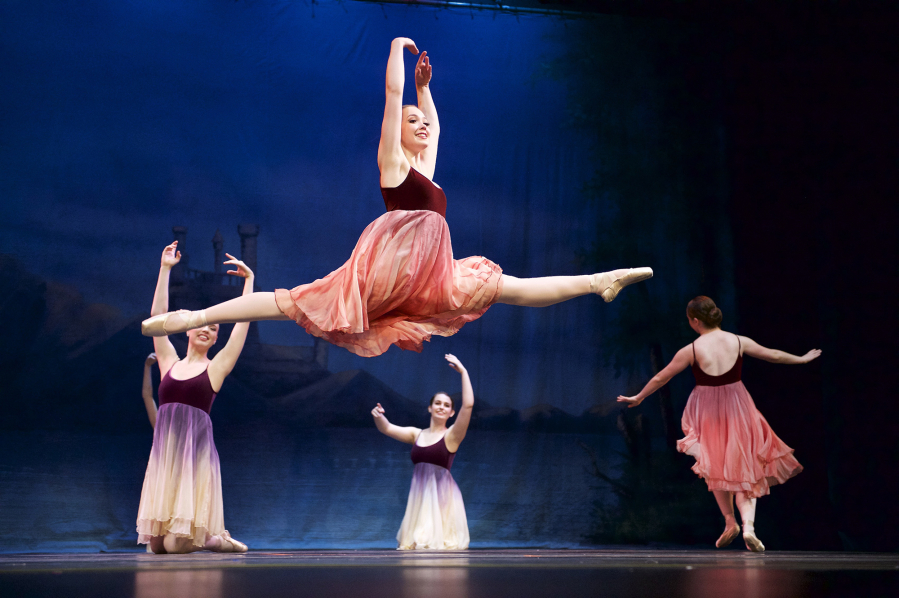Amara Malcom loves the structure and discipline of classical ballet, where there’s a right way and a wrong way.
She also loves jazz dance for its fluidity and freedom. And, of course, she loves her friends. But friendships can be as fluid and free as dance, especially when you’re 17. Sometimes friends move on or move away, break down or break up. Other times, young friendships feel as solid and dependable as the dance floor.
You can see how Malcom sets in motion the complicated dynamics of friendship in her first choreographed dance for a company, as the Columbia Dance Center in downtown Vancouver presents its annual Choreographers Showcase. It starts at 6 p.m. today at Columbia Dance, 1700 Broadway.
“The point is to encourage choreographers to try being creative and take risks in a safe environment,” said Jan Hurst, the artistic director at Columbia Dance. Students today are so trained to absorb and regurgitate information on standardized tests, Hurst said, she’s a little concerned for their spirit of creativity.
Dance can feel like a risky venue for creativity, she added, because it’s so public. Writers and painters can tuck themselves away from the world, she said — and dally as long as they please over every word and brush stroke — but choreographers ultimately must work in real time, with real dancers, in front of live audiences. Columbia Dance’s annual Choreographers Showcase helps them build confidence, she said.
Before they reach the stage, however, choreographers are known to map out their dances in any number of ways, Hurst said. “Labanotation” is an abstract system of symbols for the dynamics of dance — parts of the body, motion and direction, time and “quality” of the movement — while “Benesh Movement Notation” blocks out movement on a five-line staff similar to the music staff. That makes it pretty handy for coordinating dance and music.
But there’s no right way, Hurst added. Many choreographers “create their own dance verbiage” using stick figures or even chess pieces, she said. Malcom said she sketches in a notebook. And these days, Hurst said, many choreographers are using convenient video technology: They record new dance works on their smartphones.
Friendly feedback
You’ll see the works of 11 young choreographers, ages 12 through 19, during today’s showcase. Each piece will be no longer than 10 minutes and feature no more than 10 dancers. There was no audition into this showcase, which was equally open to all applicants who paid the nominal $15 fee.
You might see some kids who just love bopping around to music, Hurst said; but you’ll definitely see some sophisticated pieces by ambitious choreographers who are thinking hard about themes and motifs and meaning in their works.
All choreographers will get friendly feedback from a panel of dance professionals. Dance adjudication is no different than critiquing any other art form, Hurst said. Was it clear and concise, or did it ramble? Did it communicate and develop a strong theme, or was it vague? Did it all fit together, or did something stick out? (What was that hint of Bollywood doing in your ballet piece? Maybe that’s actually the seed of a separate work?)
In the end, first- and second-place winners will take home $250 and $100, respectively, as well as the opportunity to stage their works again, at a Columbia Dance performance on June 4.
Choreography is a skill every dancer should develop, Hurst said, because the world of professional dance is growing more crowded and competitive all the time. Dance companies always need choreographers, she said, and dancers who can’t find work — or get injured — are glad to be able to put choreography to use.
Groupings
Sometimes dance has a definite storyline, Malcom said — think, for example, of “The Nutcracker” or “Romeo and Juliet.” But sometimes, dance is more abstract, expressive, moody. “That’s what I find interesting,” she said.
In Malcom’s untitled piece about churning friendships, 10 dancers will perform for about 6 1/2 minutes — moving in and out of groups, leaving individuals isolated, welcoming them back.
“I’m trying to play with relationships between friends. It’s all about feelings about friends,” she said. “It’s kind of the way life happens. Friends move apart and move away. But sometimes they come back, too. I like playing with all these different groupings.”
“Grouping” 10 dancers to get her piece rehearsed and ready has not been easy, she added. All are students with busy schedules — Malcom herself is a Skyview High School student who’s also doing the Running Start program at Clark College — and the rehearsals have sometimes been pushed pretty late into the night, she said. Columbia Dance offers studio time and space as its young choreographers get ready for this showcase, Hurst said.
Malcom said she started dancing at Columbia Dance when she was 3. At that age, what she really enjoyed was the community and atmosphere, she said, but eventually she realized she’d grown serious about dance itself. When interviewed her earlier this week, she and others from Columbia Dance were just back from the Regional Dance America/Pacific conference in Phoenix, Ariz., where they took classes and performed. Malcom, who graduates next month, said she’s getting involved with some small dance companies in Portland, and looks forward to a career as a dancer and choreographer.
“It’s become my passion,” she said.




